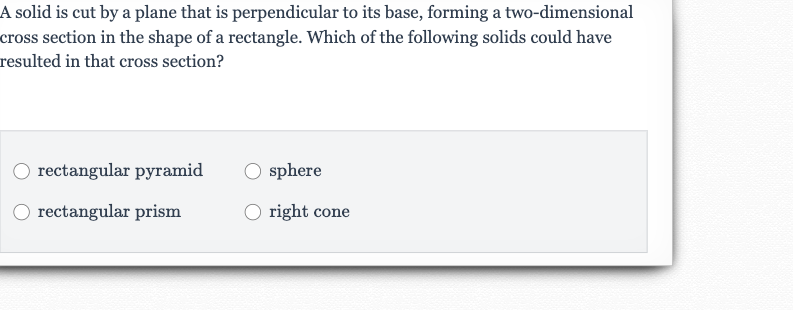AI tutor
Welcome to Bytelearn!
Let’s check out your problem:

A solid is cut by a plane that is perpendicular to its base, forming a two-dimensional cross section in the shape of a rectangle. Which of the following solids could have resulted in that cross section?rectangular pyramidsphererectangular prismright cone
Full solution
Q. A solid is cut by a plane that is perpendicular to its base, forming a two-dimensional cross section in the shape of a rectangle. Which of the following solids could have resulted in that cross section?rectangular pyramidsphererectangular prismright cone
- Identify characteristics: Identify the characteristics of the cross section. A rectangle has four sides with opposite sides being equal and parallel, and it has four right angles. This means that the solid must have a flat surface parallel to the base to create such a cross section when cut perpendicularly.
- Analyze rectangular pyramid: Analyze the first option: a rectangular pyramid. A pyramid has triangular sides that converge to a single point. If you cut a pyramid with a plane perpendicular to its base, you cannot get a rectangle because the sides are not parallel and do not form right angles.
- Analyze sphere: Analyze the second option: a sphere. A sphere has no flat surfaces, and any cross section through a sphere is a circle or an ellipse, not a rectangle.
- Analyze rectangular prism: Analyze the third option: a rectangular prism. A rectangular prism has flat faces and a rectangular base. If you cut a rectangular prism with a plane perpendicular to its base, you can indeed get a rectangular cross section because the sides of the prism are parallel and form right angles.
- Analyze right cone: Analyze the fourth option: a right cone. A cone has a circular base and a single curved surface that tapers to a point. A cross section perpendicular to the base of a cone would be a circle, not a rectangle.
More problems from Coterminal and reference angles
QuestionGet tutor help
QuestionGet tutor help
QuestionGet tutor help
QuestionGet tutor help
QuestionGet tutor help
QuestionGet tutor help
Question
. Find the value of in degrees.Write your answer in simplified, rationalized form. Do not round.____
Get tutor helpQuestionGet tutor help
